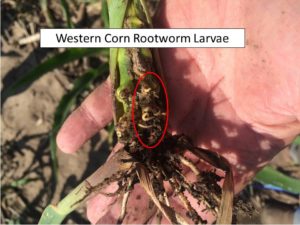Published March 1, 2021 | By Mike Petersen
I know that most of us are still shivering just a little after the cold that swept 2/3rds of the Nation and here I am offering some clues to CRW and what our industry sees as aid in getting farmers back on tops to control if not really suppress these pesky worms. Some of you may have caught this information, if so it is a repeat but for others as we look to readying the field to plant corn into whether we are planting into 2020 Soybean ground of 2020 corn, corn root worm (CRW) stares us in the face:
“Managing CRW populations is complex, as there is just not one thing that can lead to increased larvae pressure. Weather can play a role. Mild winters and springs can create prime conditions for CRW egg survival due to warmer soil temperatures. Soil moisture can also influence egg survival and hatch later.” The article in AgriMarketing went on…
“Like many pests, CRW are very adaptable. Populations are one of CRW species in some regions have begun to lay eggs in soybean fields to get around crop rotations. If the soybean field is planting with corn the next year, when thos eggs hatch, the insects will again feed on corn roots. Another species has figured out how to keep their eggs dormant in soils for an entire year – a tactic called ‘extended diapause’. This allows them to remain in the soil, even through crop rotation, and then emerge when corn is planted again.”

Several CRW larvae doing their root munching. Courtesy Kansas State University
CRW pressure is additionally fueled when growers rely upon Bt corn hybrids that employ just one mode of action. As CRW has evolved over the last 22+ years, the insect has developed resistance to certain traits in these hybrids and the farmer sees the detrimental effects. Pioneer, part of the DuPont-Pioneer organization has moved their product lines to employ multiple modes with their Qrome technology. Bayer Crop Sciences are doing much the same as is Syngenta.
We at Orthman do not want to gloss over the real threats that CRW and ECB (European Corn Borer) or WBC (Western Bean Cutworm) are never very far away from checking out your fields either. A good Pest Management program of seed coatings like Poncho or Cruiser or even incorporating insecticides during the planting step if the pressures are great is very smart. The tilled zone we offer with the 1tRIPr Strip Till tool is very important and allows you as a grower to make the incorporation of insecticides an easy step.